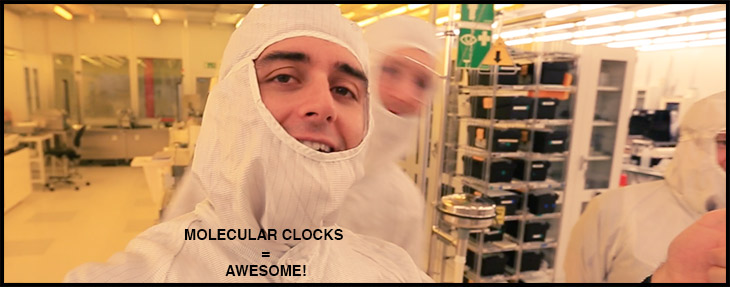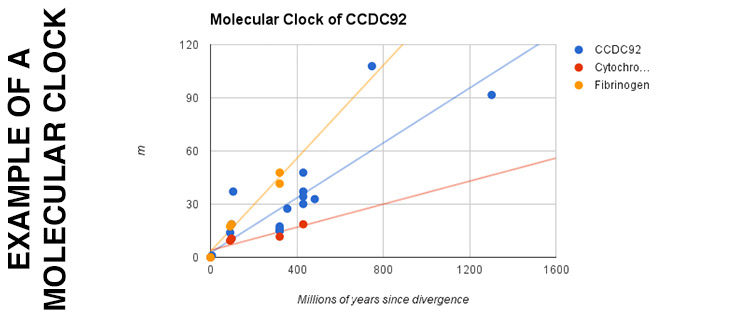What is the molecular clock?
You read and hear it all the time—“this is an ancient, million-year-old species,” or, “this animal has been around for hundreds of thousands of years.” But, how do scientists really know how old these species are? It’s not like they can use a time machine to see—not yet, at least. But the molecular clock can help make some estimates.
It’s not magic. It’s not even just a random guess. It’s actually just a basic math problem. Scientists make a few measurements and plug the numbers into an equation to get an estimate of a species’ age. This technique is called the molecular clock, and it was thought up by scientists Linus Pauling and Emile Zuckerkandl in 1962.
How does the molecular clock work?
Measuring the age of a species with the molecular clock technique requires just two simple things: an estimate of the number of genetic mutations between a species and its closest relative and the average genetic mutation rate (i.e., how many mutations show up in a population in a specified time frame, such as 5 mutations per year).
To show how this works, let’s take a simple hypothetical example. Let’s pretend that we’re taxonomists—biologists who study how organisms are related to each other. We’re given the job of trying to figure out how different turkeys are related to each other, and there are two species—the Ocellated Turkey (Meleagris ocellata) and the Wild Turkey (Meleagris gallopavo).
Let’s say we analyze the DNA of the two species and find that there are 5,000 mutations that are different between them. We also know the mutation rate: the species will show 1,000 new mutations every million years, or 0.001 mutation/year. If we divide the number of mutations by the mutation rate (5,000 mutations ÷ 0.001 mutation/year), we find out that these two turkey species are about 5 million years old. Ta da!
This approach doesn’t come without limitations, though. You need to assume that the genes mutate at the same rate. If the genes go through periods where they change very quickly and then don’t change at all, then it’s like having a yardstick with random ticks on it. You can’t use it to measure distance (or time) any more.
Because of this limitation (and others), there is actually a lot of science and math that goes on behind the scenes of a lot of these calculations. But at its essence, it’s just measuring the passage of time by using the mutation rate as a yardstick.
How do scientists use the molecular clock?
The molecular clock basically measures the amount of time since two species have diverged from each other. Obviously, this would be really useful information for someone who is putting together a family tree for related species (called a phylogenetic tree), but scientists can use this information for more than just planning really epic family reunions.
Phylogenetic trees help us make sense of the world. We can see which species are related and how closely, and we can use this information for conservation measures. For example, some scientists have proposed bringing back wooly mammoths (Mammuthus primigenius) with the help of elephants. Indian elephants (Elephas maximus) are the closest living species to the wooly mammoth, having split from each other about 7 million years ago. By using similar, non-endangered species in conservation efforts for things like raising offspring, the chances of success are greatly increased.
Believe it or not, molecular clocks are also useful in forensics and epidemiology! Scientists have successfully used the molecular clock method to prove that one person infected another person with a disease, such as the case of this Spanish anesthetist who infected hundreds of patients with hepatitis C. Scientists also use the molecular clock technique to track evolving pathogens like the Zika virus or Mycobacterium tuberculosis.
The molecular clock – don’t leave home without it!
The molecular clock has proved to be an invaluable tool in an evolutionary biologist’s toolkit. Without it, we wouldn’t have a complete picture about the natural history of our world. For many organisms that don’t fossilize well, like jellyfish or bacteria, it’s the only technique that scientists can use to date the species.
Related Topics
You read and hear it all the time—“this is an ancient, million-year-old species,” or, “this animal has been around for hundreds of thousands of years.” But, how do scientists really know how old these species are? It’s not like they can use a time machine to see—not yet, at least. But the molecular clock can help make some estimates.
It’s not magic. It’s not even just a random guess. It’s actually just a basic math problem. Scientists make a few measurements and plug the numbers into an equation to get an estimate of a species’ age. This technique is called the molecular clock, and it was thought up by scientists Linus Pauling and Emile Zuckerkandl in 1962.
How does the molecular clock work?
Measuring the age of a species with the molecular clock technique requires just two simple things: an estimate of the number of genetic mutations between a species and its closest relative and the average genetic mutation rate (i.e., how many mutations show up in a population in a specified time frame, such as 5 mutations per year).
To show how this works, let’s take a simple hypothetical example. Let’s pretend that we’re taxonomists—biologists who study how organisms are related to each other. We’re given the job of trying to figure out how different turkeys are related to each other, and there are two species—the Ocellated Turkey (Meleagris ocellata) and the Wild Turkey (Meleagris gallopavo).
Let’s say we analyze the DNA of the two species and find that there are 5,000 mutations that are different between them. We also know the mutation rate: the species will show 1,000 new mutations every million years, or 0.001 mutation/year. If we divide the number of mutations by the mutation rate (5,000 mutations ÷ 0.001 mutation/year), we find out that these two turkey species are about 5 million years old. Ta da!
This approach doesn’t come without limitations, though. You need to assume that the genes mutate at the same rate. If the genes go through periods where they change very quickly and then don’t change at all, then it’s like having a yardstick with random ticks on it. You can’t use it to measure distance (or time) any more.
Because of this limitation (and others), there is actually a lot of science and math that goes on behind the scenes of a lot of these calculations. But at its essence, it’s just measuring the passage of time by using the mutation rate as a yardstick.
How do scientists use the molecular clock?
The molecular clock basically measures the amount of time since two species have diverged from each other. Obviously, this would be really useful information for someone who is putting together a family tree for related species (called a phylogenetic tree), but scientists can use this information for more than just planning really epic family reunions.
Phylogenetic trees help us make sense of the world. We can see which species are related and how closely, and we can use this information for conservation measures. For example, some scientists have proposed bringing back wooly mammoths (Mammuthus primigenius) with the help of elephants. Indian elephants (Elephas maximus) are the closest living species to the wooly mammoth, having split from each other about 7 million years ago. By using similar, non-endangered species in conservation efforts for things like raising offspring, the chances of success are greatly increased.
Believe it or not, molecular clocks are also useful in forensics and epidemiology! Scientists have successfully used the molecular clock method to prove that one person infected another person with a disease, such as the case of this Spanish anesthetist who infected hundreds of patients with hepatitis C. Scientists also use the molecular clock technique to track evolving pathogens like the Zika virus or Mycobacterium tuberculosis.
The molecular clock – don’t leave home without it!
The molecular clock has proved to be an invaluable tool in an evolutionary biologist’s toolkit. Without it, we wouldn’t have a complete picture about the natural history of our world. For many organisms that don’t fossilize well, like jellyfish or bacteria, it’s the only technique that scientists can use to date the species.


































































































